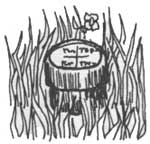|
The Clearwater Story: A History of the Clearwater National Forest |

|

Chapter 9
Boundaries
The Clearwater National Forest, according to Major Fenn, is one of the offsprings of the old Bitter Root Forest Reserve, proclaimed in 1897 by President Cleveland. This Bitter Root Forest Reserve embraced an area of about 4,147,200 acres and included territory in both Idaho and Montana, now part of the Bitterroot, part of the Lolo, all the Nezperce and a greater part of the Clearwater National Forests. It was divided into two jurisdictions, Bitter Root Idaho and Bitter Root Montana. The Idaho section was further divided into the northern and southern divisions.
The boundary of the Bitter Root Reserve, including the area now in the Clearwater Forest, followed the present western edge of the Forest along the range line between Township 5 and 6 E. to near Pierce. From Pierce it went due east 24 miles along the township line between Townships 36 and 37 N. to near Porphy Peak. At Porphy Peak it went north 12 miles along the range line between Townships 9 and 10 E. to near Junction Mountain. From Junction Mountain it went due east along the township line between Townships 38 and 39 N. to the Montana line.
While the Forest Reserve had this boundary, some lands were taken under Timber and Stone and Lieu Selection Acts in the Orogrande and Weitas country.
In March 1905 the Shoshone Forest was withdrawn. It included all the present Clearwater National Forest not included in the former Bitter Root Reserve, except T. 38 N., R. 7 E., and a part of T. 37 N., R. 6 E. A large part of this township was patented under the various land laws.
In 1906 the Coeur d'Alene Forest was proclaimed. It included the former Shoshone National Forest and added Township 38 N., R. 6 E., to the Forest.
In 1907 the Clearwater Forest was proclaimed. It included all the present Clearwater Forest except the Palouse District, and all the old Selway Forest. Its headquarters was at Kooskia, Idaho.
Following the severe fires of 1910, it became evident that the Forests were too large for efficient management. The old Clearwater Forest was, therefore, split by proclamation in June of 1911. The Clearwater Forest, as proclaimed in 1911, included all of the National Forest lands in Orofino and Lolo Creeks and all the North Fork of the Clearwater except the drainage of the Little North Fork and T. 41 N., R. 5 E., and 6 E. The latter areas were in the St. Joe Forest.
By executive order in 1931, T. 41 N., R. 6 E. was transferred to the Clearwater Forest. Lands in T. 41 N., R. 5 E. south of the river remained in the St. Joe Forest. This still did not make a logical boundary.
In October 1934 the Selway Forest was split and added to adjoining Forests. A number of boundary adjustments were made. Boundaries were usually drawn on the basis of fire protection. Each area was assigned to the Forest or Ranger District that could get there first in case of fire. The north boundary of the Clearwater Forest was roughly the divide between the Little North Fork and St. Joe Divide. The east boundary was the State line.
The south boundary was very irregular, as follows: starting near Woodrat Mountain it ran northeasterly along the divide between the branches of Lolo Creek and the Middle Fork and Lochsa Rivers to the head of Canyon Creek. Then southeasterly along the divide between Fish Creek and the streams that drain into the Lochsa River to McLendon Butte. From McLendon Butte to the mouth of Big Stew Creek. Thence up Big Stew Creek to Huckleberry Mountain. From Huckleberry Mountain along the ridge to East Peak, thence down Lizzard and Rhoda Creeks and up the South Moose to the divide between Moose and Warm Springs Creeks. From there it went over McConnell and Bear Mountains to the Lochsa at the mouth of Fish Lake Creek, thence down the Lochsa to the mouth of Indian Grave Creek and up the ridge between Indian Grave and Lost Creeks to the Lochsa and North Fork Divide west of Indian Grave Peak. Thence along the ridge between Weitas and Gravey Creeks and then Gravey and Monroe Creeks to Raspberry Butte, thence to Lunde Peak and along the ridge eastward to the State line.
During the depression years (1930-1939) much land in Clearwater and Latah Counties passed into county ownership and then was donated to the National Forest. A large acreage was also donated to the National Forests by timber companies.
By 1956 the Lewis and Clark Highway had passed the Lochsa Ranger Station. A more logical Forest Boundary then became possible and necessary. On July 1, 1956, the south boundary of the Clearwater National Forest became the Middle Fork of the Clearwater River to Lowell. From Lowell it followed the divide between the Lochsa and Selway River to just west of McConnell Peak, thence over Bear Mountain to the mouth of Fish Lake Creek, down the Lochsa to Indian Grave Creek, up the ridge between Indian Grave and Lost Creeks, along the divide between the Lochsa and North Fork to Spring Mountain, across Cayuse Creek to Blacklead and on this ridge to the State line.
In 1956 the areas donated to the National Forest south of the North Fork of the Clearwater were proclaimed a part of the Clearwater National Forest.
In 1959 the boundary between the St. Joe and Clearwater Forest was adjusted in Townships 41-5 and 41-6, the Clearwater taking lands in these two townships south of the Little North Fork.
The Powell District of the Lolo National Forest was added to the Clearwater National Forest in 1961 and the Palouse District became a part of the Clearwater in 1973.
| <<< Previous | <<< Contents>>> | Next >>> |
|
clearwater/story/chap9.htm Last Updated: 29-Feb-2012 |